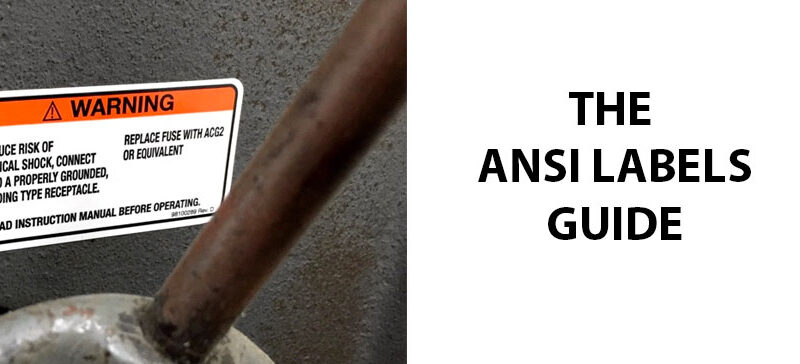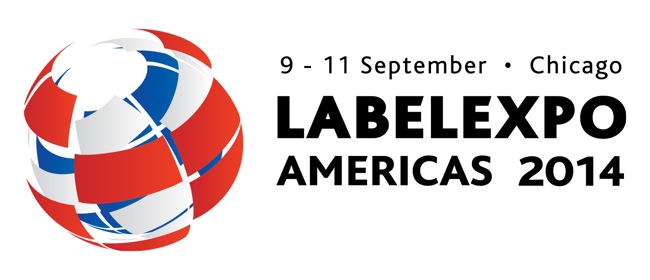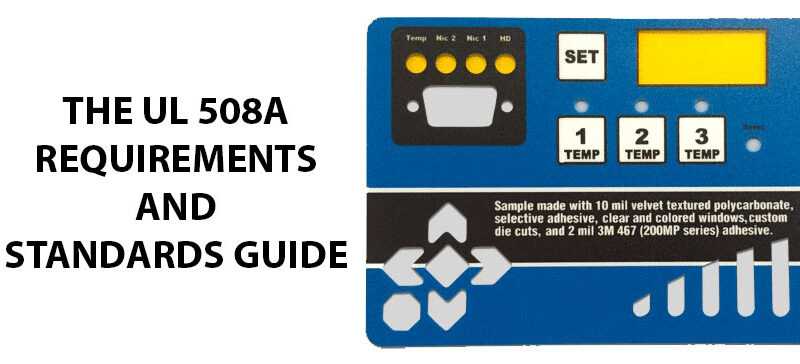The American National Standards Institute, or ANSI, is a non-profit organization that publishes standards that are related to technical safety in manufacturing and consumer products. ANSI labels, which are used to promote safety and provide important information, are a key component of ANSI standards.
But what exactly are ANSI labels? And why might you need them in your industry? Read on to learn more!
What Are ANSI Labels?
ANSI labels are used in a variety of industries to create a safer environment. These labels alert users to important safety information, including hazards and dangers as well and instructions for safe operation.
ANSI labels must follow specific guidelines–set by ANSI–to ensure they are clear, consistent, and easy to see. Plus, ANSI safety labels must be resistant to UV exposure, heat, chemicals, and abrasion. This ensures that they
ANSI labels are often used on equipment, machines, and consumer products to convey warnings, instructions, and safety precautions.
ANSI Labeling Standard
The ANSI labeling standard is a set of guidelines and requirements published by ANSI regarding the design and use of safety labels. When designing ANSI labels for your workplace, you’ll need to research the ANSI labeling standards to understand the regulations that apply to your labeling situation.
According to ANSI Z535.4, ANSI safety labels “should alert persons to a specific hazard, the degree or level of hazard seriousness, the probable consequence of involvement with the hazard, and how the hazard can be avoided.”
Here are some key components of the ANSI labeling standard:
- Safety header and signal word: ANSI labels have a safety header and signal word, such as danger, warning, caution, or notice. These signal words help users identify the level of hazard.
- Safety symbols: Safety symbols are pictograms that help clearly communicate the hazard, even when there is a language barrier. For example, if a machine has a pinch point, the safety symbol might depict a hand being caught in the pinch point.
- Message: The message explains the hazard in clear, concise language.
Types of ANSI Labels
ANSI labels are used nationwide across a variety of industries to promote safety. Each type of label serves a different purpose. Here are some of the types of ANSI labels and their best uses:
- Caution labels: Caution labels usually have a yellow background with black text and symbols. They are used to warn people about hazards that could result in minor to moderate injury. These ANSI labels are commonly used on machinery, equipment, and hazardous areas.
- ANSI warning labels: ANSI warning labels have an orange background with black text and symbols. They warn of hazards that could result in serious injury or death if not avoided. ANSI warning labels are often found on machinery, chemicals, electrical panels, and other high-risk areas.
- Danger labels: Danger labels have a red background with white text and symbols. These labels indicate immediate hazards that could result in severe injury or death. Danger labels are usually found on equipment with high-risk components.
- Notice labels: Notice labels convey important information that is not related to safety hazards. These types of ANSI labels have a blue background with white text and symbols. They are best used to provide instructions, guidelines, or general information.
ANSI Pipe Labeling
In any industrial facility, marking pipes can be an important safety precaution. The ANSI pipe labeling standards, also called ANSI/ASME A13.1, provide guidelines for identifying pipes and their contents. These labels use color-coded labels and text to convey the contents of the pipe (such as water, steam, gas, or chemicals), the flow direction, and potential hazards. Using this type of label to mark pipes in your facility helps prevent accidents that might damage your property or harm employees.
ANSI a13.1 Electrical Conduit Labels
In addition to pipe labeling, ANSI/ASME A13.1 provides standards for identifying electrical conduits. These standards include which colors and text to use to communicate the type of electrical wiring, voltage level, and potential hazards. ANSI A13.1 electrical conduit labels are important because they help electricians, maintenance personnel, and emergency responders identify wiring systems and stay safe around electrical conduits.
ANSI Cable Labeling Standards
For cables used in computer and IT environments, ANSI TIA 606-B provides cable labeling standards for identifying and marking cables. While ANSI cable labeling standards are optional, they are beneficial for reducing cable-related errors while also improving troubleshooting and maintenance.
Some of the main components of ANSI labeling standards include:
- Consistency: These labels should be used to mark cables throughout your facility. This ensures that everyone working with the cables will understand the labeling.
- Identify physical locations: ANSI cable labels should clearly state where the cable leads to. This might include the floor, room, and building.
- Easy to read: As is true of all these labels, cable labels should be clear and easy to read.
- Durable: Per the ANSI cable labeling standards, these labels must be made from durable materials that will last for the life of the cables.
- Universal agreement: Everyone in the company needs to agree to label the cables this way so there isn’t confusion.
- Persistent: Cables should be labeled at both ends.
ANSI Safety Labels
These labels may have a lot of rules and regulations, but they can truly create a safer work environment. If you’re in need of ANSI safety labels, you’ve come to the right place. Coast Label specializes in manufacturing custom labels–including these labels–that are durable enough for industrial settings. Contact us today to get started designing your ANSI safety labels!



